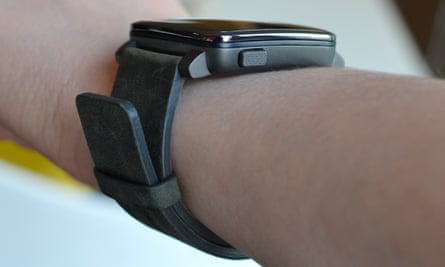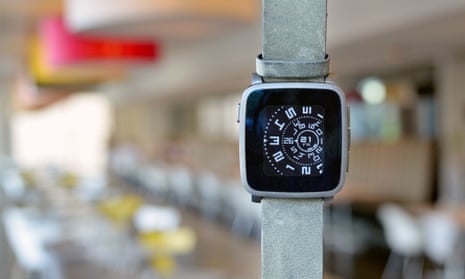The Pebble Time Steel is an all-metal version of the crowdfunded iPhone and Android compatible smartwatch – and it lasts for an astounding 150 hours per charge.
If the best smartwatches are all about notifications and controlling a few things that make sense on an always-in-reach screen, the Pebble is the purest embodiment of that idea.
Stainless steel

The big difference between the Time, which launched early this year, and the Time Steel is the watch’s body. A small piece of black matt plastic is sandwiched between a “marine grade” stainless steel back and bezel with a hardened curved glass screen.
The four buttons are also textured metal and have a quality feel to them that makes them satisfying to push.
The back is curved, fitting to the wrist and with relatively small dimensions of 47mm by 37.5mm. That means it’s comfortable to wear compared to most other much larger smartwatches. The Steel is actually bigger than the original Time, which measured 40.5mm by 37.5mm, and is 1mm thicker at 10.5mm instead of 9.5mm.
That increased size makes the screen look slightly smaller with larger bezels, but the watch looks and feels more premium, and weighs 62.3g making it 19.8g heavier than the non-metal Time, but lighter than most other smartwatches.
The Pebble Time Steel simply feels like a normal digital watch on the wrist, which most smartwatches do not.
150 hours per charge

The Time Steel has a larger battery and lasted 150 hours during my testing with hundreds of notifications, lots of fiddling with and use of music controls, apps and timers, and fitness tracking using the Misfit app. That equates to six days and six hours of use, day and night, including fitness and sleep tracking – or just over nine days if turned off overnight.
The Steel also has a low-power mode, which kicks in when the battery hits 0% charge and just displays the time. As of publication this low-power mode has lasted over 24 hours and is still going.

It is the longest lasting smartwatch by far, and the standard to which all smartwatches should aim for. For comparison, the Sony Smartwatch 3 lasts up to two days per charge and is the longest lasting of the Android Wear smartwatches, while the Apple Watch only lasts a day.
The watch comes with a magnetic charging cable and charges in just over two hours.
The screen is the same as the standard Time – a colour e-paper display that’s always on and readable in direct sunlight. A backlight, ambient light sensor and motion sensing make sure that it’s readable at night too.
The Time Steel comes with a nubuck strap, which feels great, but will take any 22mm wide standard watch strap, including metal ones. The watch is also waterproof to 30m.
Android and iPhone support

The rest of the watch behaves precisely the same as the Pebble Time. Pairing, setup, navigation, apps and music controls are the same.
For more information on setting up and using the Pebble Time on either an iPhone or an Android smartphone see:
Price
The Pebble Time Steel is available in black, silver or gold for £230, which is £50 more than the ordinary Pebble Time. It is also available with a metal strap for £270.
For comparison, the Apple Watch Sport costs upwards of £300, while Google’s Android Wear watches such as the Sony Smartwatch 3 or LG Urbane cost between £100 and £300.
Verdict

The Pebble Time Steel takes an already good smartwatch and adds longer battery life, a larger case and premium feel. It looks great in the same way metal Casio watches do, which is personal taste of course, and is easy to live with.
It does notifications, music controls and watch functions well, is always readable and doesn’t try too hard to be a jack of all trades and end up a master of none.
Whether the Steel is worth £50 more than the Time, which has a metal bezel but plastic body, is debatable. Other decent smartwatches are available in the £200 to £250 range with more features. But like the ordinary Time, the Pebble Time Steel is arguably one of the best smartwatches currently available and one of very few that work with both Android and iPhones.
Pros: 150-hour battery life, comfortable, metal body, always-readable screen, waterproof to 30m, cross-platform, lightweight
Cons: cannot mute the phone, small screen, large bezels, more expensive than Time, less capable than Android Wear or the Apple Watch
Other reviews
Pebble Time with an iPhone: the simple but effective answer to Apple Watch
Pebble Time with Android: better on Android than iPhone
Which was the best smartwatch of 2014?
Apple Watch review: beautiful hardware spoiled by complicated software
Sony Smartwatch 3 review: great design, good screen and decent battery

Comments (…)
Sign in or create your Guardian account to join the discussion